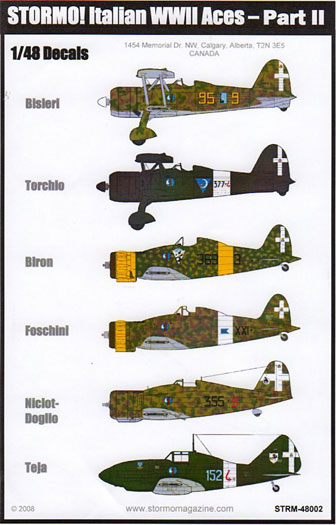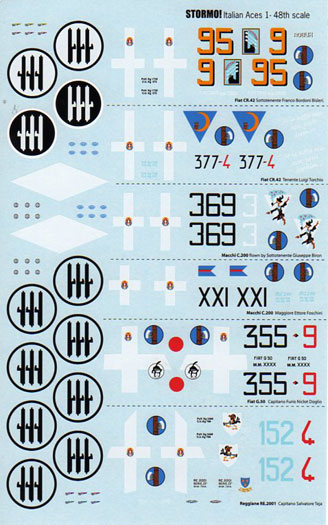Italian WWII Aces Pt. 2

Stormo Decals, 1/48 scale
|
Summary |
|
Catalogue Number: |
Stormo Decals STRM-48002 - Italian WWII Aces Part 2 |
|
Scale: |
1/48 |
|
Contents and Media: |
Waterslide decals for six aircraft plus profiles, instructions and notes |
|
Price: |
USD$13.99 from Stormo Magazine |
|
Review Type: |
FirstLook |
|
Advantages: |
Excellent subject matter, printing, registration and detail |
|
Disadvantages: |
You will need separate research material, only a side profile given. |
|
Recommendation: |
A great decal sheet as long as you have references. |
Reviewed by Steven "Modeldad" Eisenman

HyperScale is proudly supported by Squadron.com
Stormo Magazine, an Italian aviation web magazine, has now issued its second in the three part series honoring Italian fighter aces of the Second World War.
Like the first set, there is a broad representation of various fighter aircraft. Unlike the first set, Part II contains additional decals for the company logos on the propeller blades.
The markings are to be used in conjunction with the decals that came in the kits. The decals also come with additional national markings of the correct color and style for the particular subject matter aircraft.
However, like Part I, the instructions can be frustrating if not down right infuriating. You only get the left profile view of each aircraft; there are no right, top or bottom views. Unless you have decent reference material, you are left to your own devices. I will point out these issues as I discuss each set of markings. It should be noted that the instructions do give reference used and indicate that help may be found at the Stormo web site.
The aircraft represented are the Fiat CR 42, Fiat CR 42CN, Macchi C. 200, Fiat G. 50 and the Reggiane Re. 2001.
The kits that one would use for the aircraft are the Classic Airframes CR. 42 and CR. 42 CN, Pacific Coast Models Macchi C. 200, The Hasegawa / Sector / Special Hobby / Flying Machines Fiat G. 50, and, although out of production, the Classic Airframes Reggiane Re. 2001.
Markings
 Fiat Cr. 42 flown by Sottotenente Franco Bordoni Bisleri, 95a Squadriglia, 18° Gruppo, 3° Stormo CT Mirafiori; Belgium; Summer 1940. The aircraft presented in a scheme of Giallo Mimetico 3 with small blotches of Verde Mimetico 2 (Green 2) and Marrone Mimetico 3 (Maroon 3). The underside is Grgio Mimetico (Gray). Fiat Cr. 42 flown by Sottotenente Franco Bordoni Bisleri, 95a Squadriglia, 18° Gruppo, 3° Stormo CT Mirafiori; Belgium; Summer 1940. The aircraft presented in a scheme of Giallo Mimetico 3 with small blotches of Verde Mimetico 2 (Green 2) and Marrone Mimetico 3 (Maroon 3). The underside is Grgio Mimetico (Gray).
However, there is much debate about not only the camouflage colors, but also the color of the codes, for those aircraft stationed in Belgium during the Battle of Britain. Based on British reports, it is possible that the camouflage was merely green blotches over a yellow base with aluminum undersides and the codes were in the same light blue as the emblem.
The absence of a top view is frustrating in that some CR. 42 aircraft had a different pattern of application of the splotches on the tops of the wing as opposed to the fuselage.
Although I do not have a picture of this particular aircraft, I also believe the individual aircraft number “9” and unit number “95” are transposed. I believe that the individual aircraft number was forward of the unit emblem on both sides.
Finally, there is a decal for this aircraft that says “ROBUR” with no indication of where it is to be applied.
Fiat Cr. 42 flown by Tenente Luigi Torchio; 377a Squadriglia Autonomo CT; Palermo, Italy, February, 1943. It is believed that this aircraft was painted in the post-Tavolo 10 color of Grigio Azzurro Scuro (Dark Blue-Gray), rather than black.
Once again, small color details are open to debate. In this case it is the color of the moon in the unit emblem and the individual aircraft number “4”. The decals in the Classic Airframes CR. 42 CN kit have the moon as white, Stormo has it as yellow. I’m inclined to believe it was yellow.
As for the aircraft number, CA has it as blue, which was commonly used on night fighter aircraft. Stormo has it in red. The only reference photo I have of aircraft of this unit shows a white band with a red “6”, so perhaps Stormo has this correct also. But, my reference photo would also mean that the individual aircraft number comes first, rather than following “377”. (Are we having fun yet?)
Finally, Stomo includes some graffiti for the cowling of this aircraft to the effect “For me there is no sleep at night”.
Macchi C.200 flown by Sottotenente Giuseppe Biron, 369a Squadriglia, 22° Gruppo Autonomo CT, Krivoj-Rog, Soviet Union. This aircraft carries a base of Verde Oliva Scuro (Dark Olive Green) base with Nocciola Chiaro 4 (Light Hazelnut 4) splotches on top. The underside is Grigio Azzurro Chiaro (Light Blue-Gray).
Again the instructions frustrate. The aircraft of the Regia Aeronautica serving in the Soviet Union carried a white recognition triangle on the top and bottom of the main wing at about mid-span. The decals include a white diamond, which when applied over the wing becomes the triangle marking. But the instructions neither mention this marking, nor does it show it in the profile.
Macchi C.200 flown by Maggiore Ettore Foschini; 21° Gruppo Autonomo CT; Gruppo Commander; Stalino, Soviet Union; May – September 1942. The aircraft is finished in a base of Giallo Mimetico 3 (Yellow 3) with Bruno Mimetico (Brown) and Verde Mimetico 3 (Green 3) splotches. The underside is Grigio Mimetico (Gray). The aircraft carries the commander’s pennant as well as the unit number in roman numerals (XXI). The fuselage band was not yet repainted, and therefore was white.
As for the instructions, they indicate that the entire cowling was yellow, the same as the previous aircraft. But the profile shows it as a yellow band around mid-cowl. I believe that it should be an all yellow cowling. Also, the recognition triangles are not discussed or shown. I believe they should be applied.
Fiat G.50 flown by Capitano Furio Niclot Doglio, 355a Squadriglia (the instructions say 356, which I believe is a typo), 21° Gruppo Autonimao, 51° Stormo,; Ciampino-Sud, Italy; August 1940. This aircraft is in a base of Giallo Mimetico3 (Yellow 3) with spotches of Verde Mimetico 3 (Green 3) and Marrone Mimetico 2 (Maroon 2). The underside is Grigio Mimetico (Gray).
This aircraft appears to be an early G. 50 (not a “bis”) with the covered tail wheel, but it does have the mass balance rudder, not the straight hinge.
Oh those instructions! The decals include a red dot, but no mention is made of it. It seems that, for reasons unknown, early G. 50 aircraft carried this red dot centered on the lower portion of the gear cover.
Reggiane RE.2001 flown by Capitano Salvatore Teja, 151a Squadriglia, 2° Gruppo Autonimo CT, Santo Pietro di Caltagirone; June 1942. This is the basic Reggiane scheme of Verde Olivo Scuro (Dark Olive Green) on top with Grigio Azzuro Chiaro (Light Blue-Gray) undersides.
This aircraft carried the cowling the coat of arms of the city of Zara (Now Zadar, Croatia which was incorporated into Italy from 1918 until 1947). This, presumably, was Teja’s hometown.
The instructions indicate that the aircraft had a yellow spinner tip, but it is not shown in the profile. There is a possibility it was white, but I cannot confirm this.
Once again Stormo has produced an excellent collection of markings. But clearly, you will have to make an effort to check resources and make modeling decisions. But don’t despair, I believe that with the little bit of information in this review, and the use of the Stormo web site, one does not have to be a Regia Aeronautical Esperto to use this set of decals for a modeling project.
It should be noted that the decals are well packaged in a plastic envelope with a thick sheet of plastic to make the envelope fairly ridged. Nice plastic sheet stock for some modeling.
I do however look forward to receiving Part III to the series. If nothing else, I get to do research.
Thanks to Vince Tassone for the review sample.
Review Copyright © 2008 by Steven "Modeldad" Eisenman
This Page Created on 12 October, 2008
Last updated 12 October, 2008
Back to HyperScale
Main Page
Back to Reviews
Page |
Home
| What's New | Features | Gallery | Reviews | Reference | Forum | Search